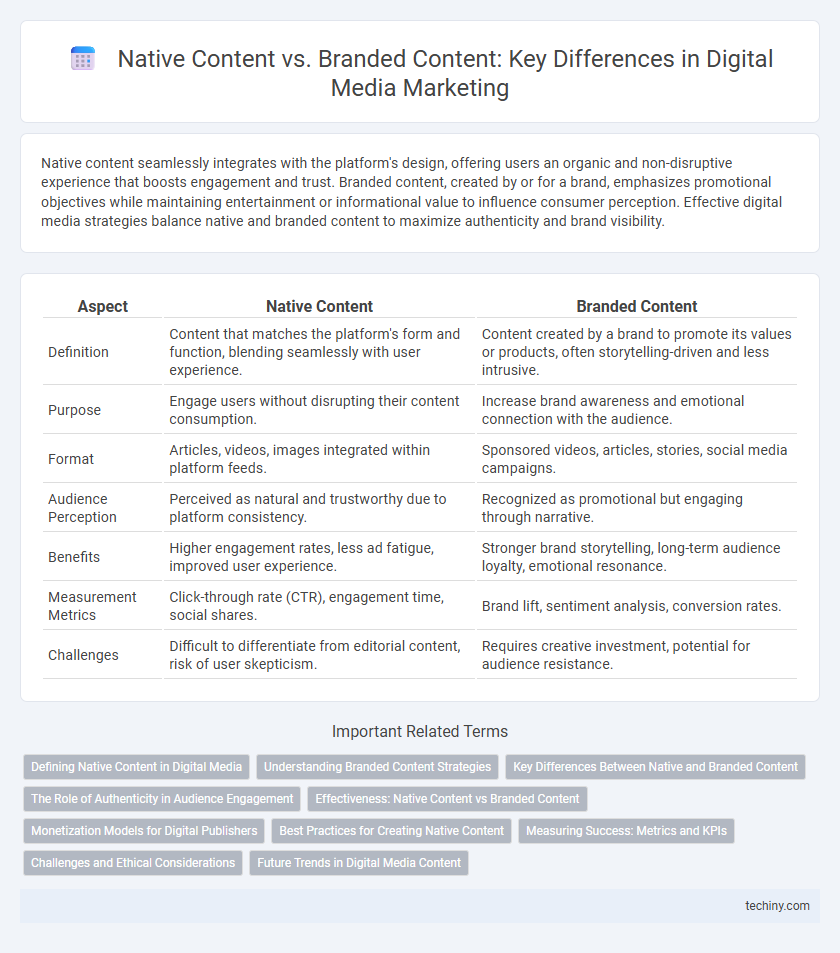Native content seamlessly integrates with the platform's design, offering users an organic and non-disruptive experience that boosts engagement and trust. Branded content, created by or for a brand, emphasizes promotional objectives while maintaining entertainment or informational value to influence consumer perception. Effective digital media strategies balance native and branded content to maximize authenticity and brand visibility.
Table of Comparison
| Aspect | Native Content | Branded Content |
|---|---|---|
| Definition | Content that matches the platform's form and function, blending seamlessly with user experience. | Content created by a brand to promote its values or products, often storytelling-driven and less intrusive. |
| Purpose | Engage users without disrupting their content consumption. | Increase brand awareness and emotional connection with the audience. |
| Format | Articles, videos, images integrated within platform feeds. | Sponsored videos, articles, stories, social media campaigns. |
| Audience Perception | Perceived as natural and trustworthy due to platform consistency. | Recognized as promotional but engaging through narrative. |
| Benefits | Higher engagement rates, less ad fatigue, improved user experience. | Stronger brand storytelling, long-term audience loyalty, emotional resonance. |
| Measurement Metrics | Click-through rate (CTR), engagement time, social shares. | Brand lift, sentiment analysis, conversion rates. |
| Challenges | Difficult to differentiate from editorial content, risk of user skepticism. | Requires creative investment, potential for audience resistance. |
Defining Native Content in Digital Media
Native content in digital media refers to material designed to seamlessly integrate with the platform's format, matching the style, tone, and function of the surrounding content. It prioritizes user experience by providing value without disrupting engagement, often appearing as sponsored articles, videos, or social posts that blend naturally with organic content. This approach improves brand credibility and audience trust by avoiding overt advertising tactics while still promoting a message effectively.
Understanding Branded Content Strategies
Branded content strategies prioritize creating authentic, engaging narratives that resonate deeply with target audiences, distinguishing themselves from native content through explicit brand integration. Emphasizing storytelling that aligns seamlessly with consumer values, these strategies leverage multimedia formats to enhance brand recall and emotional connection. Data-driven insights inform content customization, ensuring higher engagement rates and long-term loyalty within competitive digital media landscapes.
Key Differences Between Native and Branded Content
Native content seamlessly integrates with the platform's design, appearing as natural editorial material without overt advertising, while branded content explicitly promotes a brand's products or values, often featuring sponsored storytelling. Native content aims to engage audiences through relevant, non-disruptive experiences, enhancing organic reach and user trust, whereas branded content focuses on brand awareness and emotional connection by delivering purposeful messages aligned with marketing goals. Measurement of native content success typically revolves around engagement metrics like clicks and time spent, contrasting with branded content's emphasis on brand lift, recall, and conversion rates.
The Role of Authenticity in Audience Engagement
Native content leverages organic storytelling that aligns seamlessly with user experience, fostering genuine connections by mirroring platform aesthetics and user interests. Branded content, while promotional, enhances authenticity through transparent messaging that resonates with audience values and trust. Authenticity in digital media drives higher engagement rates, as audiences prefer relatable narratives over overt advertisements, which strengthens brand loyalty and social sharing.
Effectiveness: Native Content vs Branded Content
Native content drives higher engagement rates by seamlessly integrating with the platform's user experience, resulting in a 25% increase in click-through rates compared to traditional branded content. Branded content, while offering stronger brand recall due to overt messaging, often suffers from lower user trust and engagement levels. Studies show native content generates up to 60% more time spent on content, enhancing overall campaign effectiveness in digital media strategies.
Monetization Models for Digital Publishers
Native content seamlessly integrates with a platform's design, driving higher engagement and CPM rates through sponsored placements tailored to audience preferences. Branded content offers digital publishers monetization via direct partnerships and custom campaigns, often commanding premium pricing due to its strategic brand alignment. Both models leverage data-driven targeting and analytics to optimize ad performance and maximize revenue streams.
Best Practices for Creating Native Content
Creating native content requires seamless integration with the platform's user experience to ensure authenticity and engagement. Prioritize audience relevance by tailoring messages that resonate with user interests while maintaining subtle brand incorporation. Leveraging data analytics to optimize content performance and adapting formats to platform-specific behaviors enhances effectiveness and drives higher engagement rates.
Measuring Success: Metrics and KPIs
Measuring success in native content relies heavily on engagement metrics such as time spent on page, social shares, and click-through rates, indicating authentic audience interaction. Branded content success is often evaluated through brand lift studies, conversion rates, and return on ad spend (ROAS), linking content directly to business outcomes. Both approaches require tracking sentiment analysis and audience retention to accurately assess impact across digital media campaigns.
Challenges and Ethical Considerations
Native content blurs the line between editorial and advertising, creating challenges in maintaining transparency and audience trust, as consumers may struggle to distinguish sponsored messages. Branded content faces ethical considerations regarding honesty and the potential for misleading endorsements, requiring clear disclosure to uphold ethical marketing standards. Both content types demand rigorous compliance with advertising regulations to avoid reputational damage and legal repercussions in digital media.
Future Trends in Digital Media Content
Native content and branded content continue to evolve as key strategies in digital media, with future trends emphasizing personalization through AI-driven data insights to enhance audience engagement. Interactive and immersive formats, such as augmented reality (AR) and virtual reality (VR), are increasingly integrated into native and branded content to create deeper user experiences. The rise of platform-specific adaptations and short-form video content will further drive the effectiveness of digital campaigns by aligning with consumer behavior and preferences.
Native Content vs Branded Content Infographic

 techiny.com
techiny.com